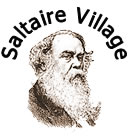Ninety-five years old in November 2006, Jack Grimley was one of the most important men in the Village in the 1950’s and 60’s. He owned and ran the local chemist shop at Number 12, Victoria Road. Number 12 was one of those shops which had not changed its function since it was built by Sir Titus in the 1850’s. George Bayley was the original chemist in 1871, followed by Mr Charlesworth, and then it became the Albion Drug Company, owned by Arthur Albert Abbott. Arthur was followed by Clarence Richardson, whose main chemist shop was at 30, Bingley Road. Clarence was a flamboyant personality, invariably wearing a bow tie. He was also a Conservative councillor. His son, Tony, became a famous film maker and director, and married Vanessa Redgrave, the film actress.
Jack bought the shop from Clarence in 1951 because Clarence couldn’t find anyone reliable to manage it for him. Jack had previously been a chemist in Queensbury, becoming an apprentice at JR Leach on the High Street there in 1928. Mr Leach had been trading there since 1922, and Jack tells the story that he put his own good health down to the fact that he took regular creosote tablets!! Jack trained at Bradford Technical College (now the University), and qualified in 1934. He then returned to Leach’s, and opened up a new branch chemists shop for them at West End, which he continued to manage until the middle of World War II. He then spent 3 years in the Navy, from 1943 to 1946, before returning to West End to re-open the branch there. The shop had been used as a warden’s post during the War. His decision to open his own business in Saltaire came after he realised that there were 3,500 people employed in the Mill and living in the Village, and so he was never going to be short of customers!
Sir Titus would have turned in his mausoleum, because one of the early changes which Jack made was to diversify his stock, and to expand the wines and spirits sales. This increased in popularity until it accounted for 25% of the business. He had to apply for separate licences for wines, spirits, tonic wine, and beer. His window display was mainly of the tonic wines because they were less attractive to smash and grab thieves, and the more expensive stock was securely kept in the shop. Bottles of Sanatogen tonic wine were 5 shillings each, whilst Sandeman’s port was 5 shillings and nine pence. Half bottles of Martell brandy were 12 shillings and 6 pence. He had some 50 bottles of wine and spirits on display in the shop on a large marble counter.
Jack also expanded into photographic equipment, and a local firm did the developing and printing. He stocked a few cameras, and recalls that you could buy a box Brownie for around 7 shillings and 6 pence. There was a dispensing machine for film on the outside wall of the shop, but unfortunately it kept being stolen. While it only held black and white film which sold for 1 shilling, and it had 20 rolls in it, Jack could just about stand the occasional loss of £1. But then colour film became popular at 5 shillings a roll and the dispenser was removed.
The pharmacy side of the business was always the most important. The local doctor was originally Dr Sharpe, followed by Drs Moody, Gaukroger, Laing, Waite and Rhodes, with surgeries at the top of Saltaire Road. Popular remedies sold at the shop included Veno’s and Owbridges cough syrup for 1 shillings and threepence and 2 shillings and 6 pence a bottle, and tonics such as Clarke’s blood mixture selling at 3 shillings and 5 shillings a bottle. Jack and his staff of 2 packed their own Aspirin tablets, and charged sixpence for 100. He made a profit of twopence on each bottle, and the remaining fourpence was accounted for largely in the cost of the bottle itself (with its cork lined cap and cotton wool insert) and the labour cost. The actual cost of the aspirin was practically negligible!
Jack bought the cottage next door to the shop (for £700, on Caroline Street) in order to accommodate his car and to provide storage for stock. He knocked out the front of the cottage on the ground floor to accommodate the car, but kept the first floor intact, with a new internal doorway linking the shop with some stairs up to the store. He lined the store with orange boxes from Harney’s greengrocers next door, to keep his medicines in. The cottage is now rebuilt.
Jack closed the shop on Christmas Eve, 1976, when his customer base was much reduced as the Mill employed fewer and fewer workers as it was run down. He continued to live above the shop for a time, before moving out of the Village. He is currently in a local care home, where I’m glad to say that he has been settled and healthy for the past year, supported by daughters Jennifer and Jacqueline.
Jack’s contribution to the health of Villagers for 25 years is something of which he is justly proud.
Roger Clarke - August, 2006

